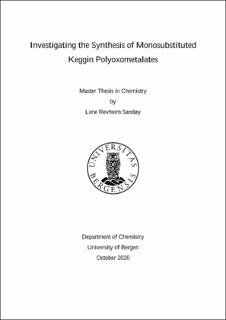Investigating the Synthesis of Monosubstituted Keggin Polyoxometalates
Master thesis
Permanent lenke
https://hdl.handle.net/11250/2711670Utgivelsesdato
2020-12-03Metadata
Vis full innførselSamlinger
- Master theses [85]
Sammendrag
For any successful catalyst, there needs to be a cheap and reliable route to synthesising the catalytic material. It is therefore desirable to find syntheses that are time efficient, do not require any highly toxic chemicals and give high yields. In this thesis, the syntheses of a range of different polyoxometalates (POMs) with the well-known Keggin structure were investigated. The compounds of interest were the potassium and tetrabutylammonium (TBA) salts of [SiXW11O39]n-, where X = Al3+, Co2+, Cr3+, Cu2+, Fe3+, Mn2+, Ni2+ and Zn2+, since they had previously shown or were suspected to have interesting catalytic properties, particularly for the cycloaddition and copolymerisation of CO2 with epoxides. In the case of the potassium salts, two different syntheses were attempted. It was found that one of the syntheses produced a higher yield and required less time than the other one. However, as opposed to the other synthesis, it produced an unknown precipitate and was not easily compatible with X = Al3+, Cr3+ and Fe3+. Regarding the TBA compounds, three different syntheses were attempted. The first synthesis resulted in low yields, was time consuming and required the use of dichloromethane (DCM), the second synthesis removed the need for DCM and was overall more effective, and finally, the third synthesis drastically improved the yield. Based on results from infrared spectroscopy (IR) and elemental analysis (EA) the desired Keggin-type POM compounds were successfully obtained. The IR data of the different compounds were thoroughly analysed and compared, and the observed differences were viewed in relation to the properties of the transition metals inserted into the structures. In addition to the IR and EA analysis, some of the compounds were also analysed using thermogravimetry (TG) and single crystal X-ray diffraction (SXRD). The investigations of the syntheses and analyses of the results presented in this work, provide a further understanding of these interesting materials, facilitating future studies of their catalytic properties.
